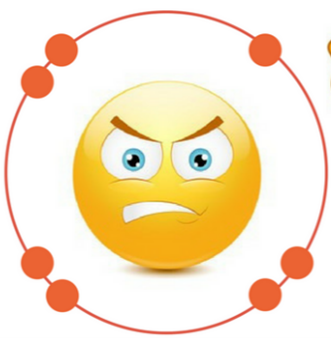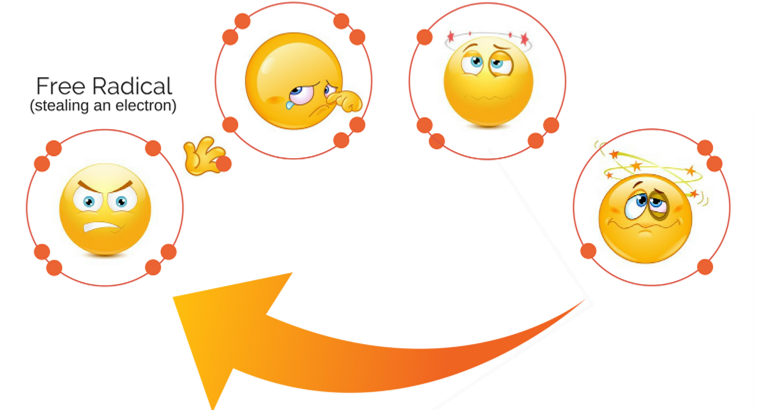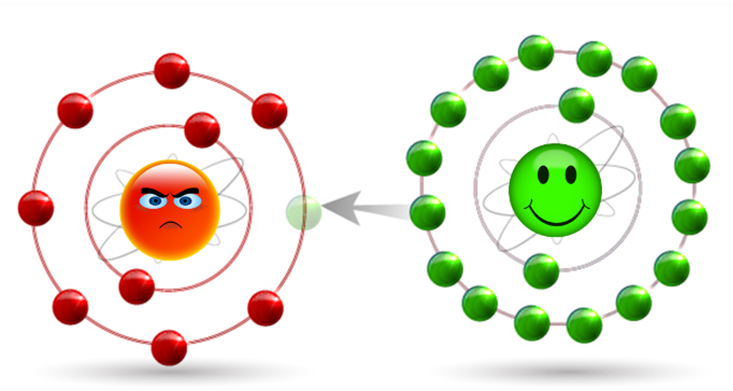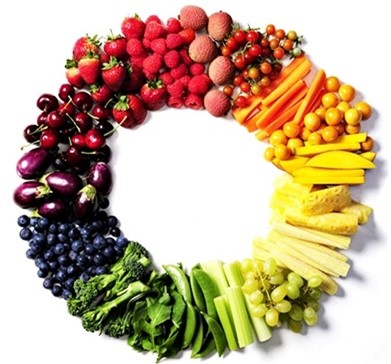Antioxidants grant some amazing benefits to our health. A little biochemistry lesson first!

First meet the little villain in this chemical story – the free radical. This little guy is an atom, the basic building block of all matter on earth. The not so happy face represents the nucleus made up of protons and neutrons. The red dots represent the electrons, which orbit around the nucleus or that little mad face. Electrons always like to have partners, so they generally come in pairs. This unhappy atom has an unpaired electron which makes it very unstable and highly reactive. When an electron loses its partner, it frantically starts a search for a new one. Any atom or a molecule (that is made up of atoms) that is missing an electron is called a free radical.

In its search for an electron partner, it sets off a chain reaction by stealing an electron from the nearest stable atom or molecule.
Although the free radical has now formed a stable atom, a new unstable atom or molecule is created and the chain reaction continues.
Free radicals are used by our bodies, for example, the immune system uses them to help kill of unwanted pathogens, and the vascular system to dilate blood vessels. They also form a crucial part of metabolizing nutrients from food into the energy we can use every day. Whilst we need some free radicals, when these free radicals accumulate in our bodies, they can cause a lot of serious damage. These unstable molecules – as the chain reaction continues- cause damage to many aspects of the cell including the DNA (leading to mutations), RNA, cell membranes, proteins (such as the enzymes and receptors), and fatty acids or lipids. These cells in turn become seriously injured, can’t function properly and can even die.

It is time to meet the hero of this chemical story – the antioxidant. Antioxidants are also known as free radical scavengers. These are truly amazing molecules, that are so stable, that they can actually donate electrons without becoming a free radical themselves. They travel around neutralizing free radicals and turning them into stable non-damaging atoms and molecules, and they prevent new ones from forming. Antioxidants are absolutely essential to the survival of all living creatures. Without them, we would die very quickly.
The final part of this biochemistry lesson is oxidative stress. This term is often used in the context of free radicals and antioxidants, but what does it actually mean? Essentially, there is an accumulation of too many free radicals and the body is not able to neutralize these, and repair the damage that they cause. There is not enough balancing antioxidants in the system. When the body is in this state, it is called oxidative stress.
There are number of things that can contribute to excessive free radicals and this oxidate stress.
- Air pollutants, pesticides and a variety of toxic industrial chemicals,
- Radiation from X-rays, excessive UV rays, and excessive electromagnetic frequencies,
- Smoking and alcohol,
- Poor food choices: processed food and fried food,
- Infections from bacteria, viruses or fungus,
- Excessive or prolonged exercise (this really is in the elite athlete realm), and
- Too much emotional stress
There are many others, but these are some of major ones.
Oxidative stress has been implicated as a contributing factor in a number of health conditions:
- Cancer,
- Heart Disease,
- Diabetes,
- Kidney Disease,
- Decreased immunity,
- Increased risk autoimmune disease and allergies,
- Alzheimers Disease,
- Parkinsons Disease,
- Arthritis aches and pains,
- Cataract formation in the eyes,
- Fatigue,
- And all the signs and symptoms of aging – including wrinkle formation
This is just to name a few.
The question now remains, what can be done to prevent the oxidative stress or the formation and accumulation of free radicals. There are a few enzymes with free radical detoxifying activity in the body, and also naturally occurring antioxidants that the body can manufacture. However, the vast majority of our antioxidants are found in the whole plant-based foods that we consume. They are found abundantly in the seeds, fruits, leaves and roots of many plants. Bear in mind, that the some of those detoxifying enzymes that our body uses, also need some other micronutrients that we obtain from plants to assist in their function as well.
There are thousands of antioxidants that we can find in the plant kingdom. Some of the common ones include:
- Antioxidant vitamins – Vitamin C, Vitamin E,
- Carotenoids – lycopene, lutein, astaxanthin and β-carotene,
- Polyphenols, that include flavonoids (which has a whole subgrouping in itself) – lignans, resveratrol, and curcumin, and
- Minerals – selenium, copper, zinc and manganese.
Is there a simple way to know where to find all these important antioxidants to include in our diet? The answer is absolutely, God has given the most eye-catching clue. It cannot be missed.
The Rainbow. It is the rainbow of colours in our plant-foods that indicate all the antioxidant goodness available for our bodies to use. We were created to see and enjoy the colours around us, and there is nothing quite like seeing a rainbow.
We first see the rainbow following the great flood in the book of Genesis and you can read about this in more detail in the 9th chapter of Genesis. In a short summary, Noah and his family were kept safe in the ark through the most severe storm that lasted 40 days, and a world-wide flood that took months to subside. Upon exiting the ark, God made a covenant – otherwise known as everlasting promise – with Noah and all his descendants (all of humanity) that He would never destroy the earth and all its inhabitants with a flood again. Although this promise, or covenant, seems specific at a superficial level, it has a much deeper and broader meaning. The other place that we see the rainbow in the Bible is around the Throne of the God (Ezekial 1 and Revelation 4) and surrounding the Lord God Himself (Revelation 10). It is here that the deeper meaning and symbology of the rainbow can be seen. His Grace, His mercy, His love, His protection and His salvation. It is the complete assurance that God is true. The Throne of God is staked on the keeping of His everlasting promise to humanity. The next time you sit down to a rainbow of plant foods on your plate, remember the Promise of Salvation from God.
A whole-food, plant-based diet is the best diet to protect against chronic oxidative stress-related diseases. This is not only due to the protective effect is due to the antioxidants, but a host of other plant substances that provide additional benefits. The beauty and simplicity of this diet is that if you are getting a good variety of the different colours, and eating a range of fruits, vegetables, legumes, grains and nuts, then you do not have to worry about getting an ample supply of antioxidants, in addition all the other good plant nutrients that are just as important to your health.
There are certain foods that are particularly rich in antioxidants. These are not necessarily superfoods, as all the whole plant-foods have benefits that go beyond the antioxidant content. Whilst one particular food may have a lower antioxidant content, conversely, it may have much higher plant nutrients for other purposes. It all balances out.
Of all the edible plants, herbs come out on top with the highest antioxidant content: peppermint, marjoram, oregano, thyme, sage, rosemary, and saffron for example. Drying these herbs preserves and concentrate the antioxidants. Sprouted seeds are often more nutrient-dense than ungerminated seeds or mature vegetables. The antioxidant content of seeds increases anywhere from 2 to 20 times, once they have sprouted. Some good sprouts to add to your diet regularly would include broccoli, soybean and mung bean. They need to be eaten within the first five to seven days of sprouting. Berries are winners in the fruit category: including blueberries, mulberries, cranberries, black currants, blackberries, raspberries, pomegranates, strawberries, red currents, and goji berries. In amongst these berries, are also red plums, granny smith and red delicious apples, cherries and figs, for those who don’t have a preference for berries. In the vegetable world, the antioxidant stand outs are the greens. In particular kale, rocket, spinach, brussel sprouts and broccoli. In the Legume or Bean family, the ones that pack the most antioxidant punch include kidney beans at the top the list, followed by black beans, pinto beans and then a variety of lentils. If you’re looking for a handful of high antioxidant nuts, be sure to include pecans, walnuts, hazelnuts and pistachios. Even though wholegrains don’t seem to have the variety or intensity of colours, there are some great options from this category. For gluten free grains, you have sorghum (the black variety), quinoa (the black or red kind), wild or black rice, buckwheat and popcorn. The gluten containing grains include the Khorasan wheat, oats, barley, spelt wheat, and rye. When you start heavily processing these grains however, use lose much of the antioxidant benefits. Therefore, eat or cook with them in their whole grain or wholemeal form.
Generally speaking, we cannot get our antioxidant needs from supplements. Research so far has not provided evidence that isolated antioxidants in supplement form have a positive impact on health. In actual fact, if too much of some isolated antioxidants are taken, it can potentially, and somewhat paradoxically, increase oxidate stress. In nature antioxidants tend to work best in combination with other nutrients, plant chemicals, and even other antioxidants. Furthermore, there are differences in the amount and type of antioxidants found naturally in foods, when compared to those found in supplements.
Antioxidants are all naturally anti-inflammatory which feeds into the protection against a number of chronic diseases. They reduce the risk of developing diabetes, but they also help to manage the diabetes by improving insulin sensitivity and regulating blood sugars. Antioxidants help to lower the risk of cancer to the bowel, prostate, skin, uterus, and breast. They do this by protecting the DNA from damage and controlling tumour growth. Antioxidants improve heart health by contributing to lower blood pressure, lower bad cholesterol, higher good cholesterol and helping to prevent blood clots. Some antioxidants have been shown to help boost the function of the brain and protect against memory loss and neurodegenerative diseases such as Alzheimer’s Disease. They can also help with mood disorders such as depression and anxiety. Gut health can also be improved by antioxidants by promoting the growth of beneficial gut bacteria and limiting the harmful ones. Independently of the fibre found in the plants, the antioxidants can also help to bulk up the stools. The anti-inflammatory benefits of antioxidants can also reduce arthritic joint pains and muscle pains. Although the ageing process cannot be stopped, we can age in a healthier way, with plenty of antioxidants – slowing down the formation of wrinkles and reducing the risk and severity of chronic diseases that may come on with age. These are just some of the major contributions that antioxidants give us.

